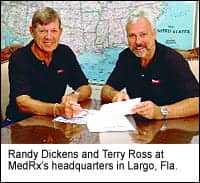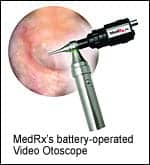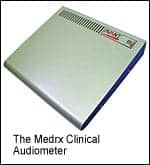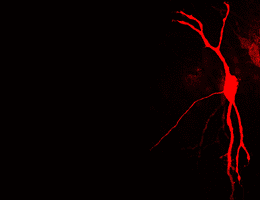
HPR: How did MedRx get its start?
MedRx: MedRx Inc began commercial operations in 1994 under the direction of its current president, Ron Buck. Buck owned and operated a successful hearing instrument practice, and in an effort to provide his patients with the best care possible, he recognized the need for an affordable, high-quality video otoscope. After he teamed up with an electrical engineer, the MedRx Video Otoscope was developed, and it became a worldwide market leader. Subsequently, MedRx has designed and developed a complete line of PC-based diagnostic and testing equipment, including audiometers, real ear measurement systems, live speech mapping instruments, and hearing aid restoration systems.
HPR: Video otoscopy put MedRx on the map within the hearing health care industry, but the company has expanded its product offerings since then. How has the industry changed in the more than 10 years since the company was formed?
MedRx: The hearing health care industry has changed dramatically in the past 10 years. Today, advancements in hearing aid signal processing require more sophisticated measurement technologies and software. This has driven our engineering and development strategy toward computerized systems, which can add speed and accuracy to both diagnostics and today’s complex fitting protocols.

MedRx: MedRx is keenly aware that in order to sustain a competitive position in the market, it must continue to listen to hearing care professionals to understand their needs, and we also must stay abreast of hearing instrument developments to ensure that our products deliver the capabilities required for advanced diagnostics and fitting.
HPR: Are those needs different in the international market versus domestically?
MedRx: MedRx has just begun to explore the opportunities in the international market. Recently, the company earned its ISO 13485 medical device certificate and will begin exporting to western Europe and the Far East in late 2006. The sales potential in the international sales arena is substantial, and the technology push in most major countries is strong. Since a large number of hearing instrument manufacturers are from outside of the United States, the same advanced solutions we are observing here are available in foreign markets as well.
HPR: What are the current challenges in testing patients’ hearing and fitting them for hearing aids, and how does MedRx address those challenges?

MedRx has a continuous product improvement [and] development strategy across the full line of instrumentation it offers. Because all of our diagnostic and fitting products are computer-driven, upgrades and improvements can primarily be implemented through software changes, lowering development time and costs for the company and the profession.
HPR: There are audiologists who do not use live speech mapping. What would you tell them about the benefits of doing so—for their patients and their practice?
MedRx: We do our best to explain to the audiologists that live speech mapping uses the voices of the clinician or patient’s family member for real ear measurements. The live speech map is presented in an easily understood graphic, empowering the patient with a clear visual perspective of the hearing loss and aided benefit as they relate to actual speech. Clinicians using live speech mapping report patients have greater confidence in the hearing rehabilitation process due to the exceptional counseling features of the approach. They also report a reduction in follow-up visits required, lower practice costs, and lower costs for the patients. The time saved in fitting the hearing instrument allows the audiologist to devote more time to patient counseling and aural rehabilitation and other clinical functions.

MedRx: There are really only a couple of reasons we have observed for audiologists not taking advantage of the benefits of live speech mapping. First, most of them were not exposed to this new protocol in their educational process. While real ear measurement has been around for nearly 30 years, a large number of professionals still do not use any legitimate verification method in their fitting protocol. Fortunately, this is changing. We are observing an increase in demand for live speech mapping and validations methodology, in general. In some states and countries, verification is becoming a mandatory protocol for hearing professionals. Second, there is some concern about the time to conduct this testing and where in the fitting process to use it. Fortunately, with the processing speed of computers today, this process takes only a few minutes and saves a great deal of postfitting time.
HPR: In November 2005, MedRx released the AVANT REM Speech™, a live speech mapping/real ear system from the AVANT line of PC/USB-based instrumentation. Since then, the company has released other instruments and accessories in the AVANT line—most recently, the AVANT A2D two-channel audiometer. What does the system offer to users?
MedRx: The AVANT™ A2D Audiometer is an advanced computerized diagnostic system only 4 x 4 x 1 inches in size. This remarkable audiometer has full two-channel testing capability and comes with either 3A insert earphones or TDH-39 headphone, bone conductor, and free field testing when connected to amplified speakers. The AVANT A2D diagnostic audiometer provides pure tone, pulsed tone, and warble tone stimuli. Masking signals—speech noise and narrow band noise (NBN) or external device (CD/tape). The system provides 1 dB and 5 dB attenuation steps. There is a maximum output to 120 dB HL for air and 70 dB HL for bone. Additional features include operator microphone and talk back capability, visual lighted indicators to ensure the correct ear is being tested, and the system is NOAH™- and TIMS™-compatible. A simple connection via a USB port on the end user’s computer will bring this computerized device to life.
HPR: Will there be further additions or upgrades to the line in the near future?
MedRx: Our research and development team is continually evolving and developing new solutions for our industry. We will be introducing some new products before the end of this year and will have a major announcement coming in the weeks ahead. We are also adding new features and protocols to our instrumentation software programs that enhance their application and usability.
HPR: What are some of the other products MedRx offers to the hearing health care industry?
MedRx In addition to the AVANT line of PC/USB-based equipment, we offer the popular UltraVac, a hearing instrument restoration system. There is also a Hearing Loss Simulator CD available that audiology practices and educational institutions have been taking advantage of.
HPR: What can the industry expect from the company in the near future, in terms of upgrades or new products?
MedRx The hearing health care industry can expect to see a reconfigured video otoscope featuring a smaller, lightweight camera. Additionally, we plan to introduce a new NOAH-compatible computerized hearing instrument test system.





